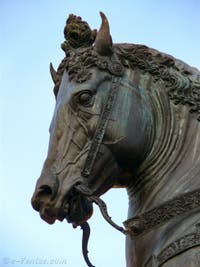Squares Arsenal | Hunchback | Dogana | Colleoni | Rioba | Piazzetta St. Mark | Stefano | Rialto Vecchio
The Equestrian Statue of Bartolomeo Colleoni (1400-1475)
by Andrea Verrocchio (1435-1488)
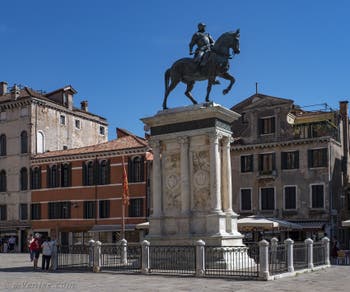
Statue of Bartolomeo Colleoni Arriving via the Ponte del Cavallo (Horse Bridge), to the right of the church of San Giovanni e Paolo is the equestrian statue of Colleoni, the famous condottiere who fought on behalf of Venice.
Born in 1400 in Solza, near Bergamo, Bartolomeo Colleoni belonged to a dynasty of warriors.
This fighter at heart knew war from his earliest youth, when the duke of Milan laid siege to his father's castle, and had him executed.
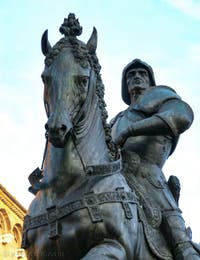
Statue of Bartolomeo Colleoni Having become a condottiere himself, he showed particular zeal in helping the Venetians fight the Milanese, who signed the peace in 1441.
His qualities as a strategist and his reputation guaranteed him many contracts, including with Milan, as this man of war knew perfectly well how to negotiate his services with sovereigns or states that needed reliable and effective support.
Colleoni was one of the most famous condottieres, those famous battlers who, in their day, were said to bloody their shirts very little” he is said to have been one of the first to use cannons, rather than resorting to hand-to-hand combat.
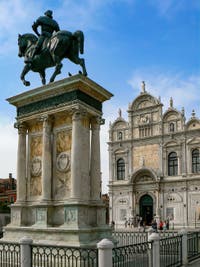
Statue of Bartolomeo Colleoni Effective tactics and less costly in terms of casualties from a leader described by historians as “More competent and loyal than Carmagnola, more cunning and subtle than Gattamalata”, two other condottieres under whom he had previously served.
Condottieres were those renowned mercenary troop leaders sought after by warring states who needed a helping hand to achieve ultimate victory.
They were rated according to their military valour, and Paul Morand said that the Colleoni's reputation was such that Louis XI and his great enemy Charles le Téméraire had long insisted that the Doge raise the stakes so that he would sublet his services to them....
Bartolomeo Colleoni (or Colleone), Captain General of Venice
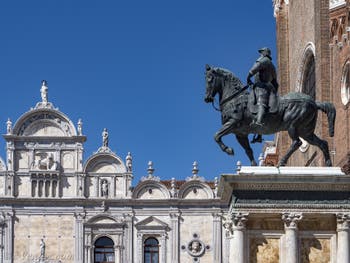
Statue of Bartolomeo Colleoni In 1448 the Venetians had offered Colleoni the position he had long coveted, that of Captain General of the Serenissima.
Since then, he has always remained loyal to Him, never betraying His interests, even when campaigning for others.
If he had made his fortune as a condottiere, the Colleoni was also a perfect manager, since he held a capital of 281,983 ducats in cash (equivalent to that of the great banker of the time, Côme de Médicis), to which was added about double that in various properties.
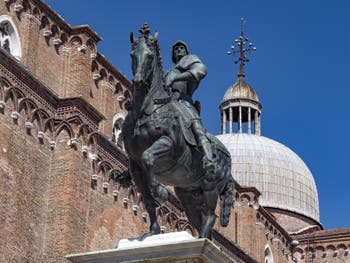
Statue of Bartolomeo Colleoni He died in his castle in Malpaga on 29 October 1475 bequeathing 100,000 ducats to Venice to help in its fight against the Turks.
In exchange for this providential aid, however, he asked that his statue be erected in the Piazza, opposite San Marco.
Venice undertook to comply, but contrary to what the Colleoni had imagined, his statue was not in the Piazza next to San Marco's basilica, but near the Scuola Grande di San Marco on the Campo San Giovanni e Paolo!!!!
The Venetians had cleverly found the solution that reconciled the Colleoni's dream of glory with the (very republican) law of Venice that forbade placing anyone's statue in the Piazza, including the evangelist San Marco!
And they didn't make fun of him, since they called on the best sculptors of the time to create it.
Statue by Bartolomeo Colleoni in Venice: Leopardi completes Verrocchio's work
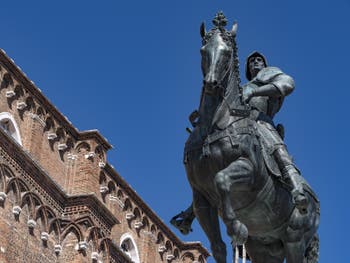
Statue of Bartolomeo Colleoni Initially, Venice turned to the great Florentine artist Andrea Verrocchio (who was the master of Leonardo da Vinci) to make the statue of the horse, and to Bartolomeo Bellano (a disciple of Donatello) to make the figure of Colleoni.
But the Maestro refused to sculpt the horse without its rider, and he returned home to Florence. Verrocchio did not return to Venice until it was agreed that he could present a project of the whole.
The projects of two other artists, Bellano (or Beliamo) and Leopardi, were exhibited at the same time as his own in 1483.

Statue of Bartolomeo Colleoni And it was Verrocchio who won with his magnificent horse representing the ideal type of “cavallo naturale de strade” (the ordinary horse of the street).
Unfortunately Andrea Verocchio died on 25 June1488 when he had just finished casting his work in clay, requesting that the casting be carried out by his disciple Lorenzo di Credi.
The Senate decided otherwise, preferring the Venetian foundryman Alessandro Leopardi who gave it his final touch by making the details of the Colleoni's armour and all the harnessing for his mount (saddle, reins, bits, etc).
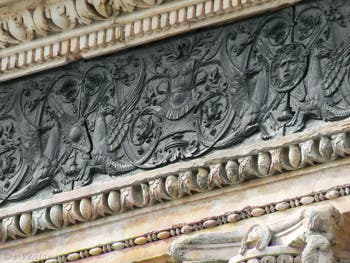
Statue of Bartolomeo Colleoni He was also responsible for the bronze frieze on the entablature of the pedestal in Istrian stone, adorned with six Corinthian columns, in perfect harmony with the façade of the Scuola San Marco.
The decoration of columns on the pedestal reminds us of the equestrian statue of the emperor Domitian, and the presence of the Colleoni coat of arms, next to the Venetian lion, can be interpreted as a token of respect and consideration for the man who, after defending Venice during his lifetime gave it providential financial support after his death.
The statue was presented to the public on 21 March 1496.
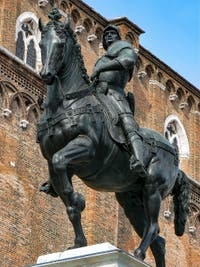
Statue of Bartolomeo Colleoni Although the location of his statue is not as prestigious as St. Mark's Square, we can believe that Colleoni forgave the Venetians' sleight of hand, since they chose the great Verrocchio, who honoured him by creating the most beautiful equestrian statue of the entire Renaissance here.
And although we may be shocked to know that Leopardi took the liberty of signing the entire work, he did so in accordance with the custom of the time, which was to retain the name of the artist who completed the work, without forgetting the role played by the artist who had preceded him in this task.
With his pedestal, he was able to bring out the full expressive richness of Verrocchio's masterpiece: the perfect pairing of horse and rider, in this case a powerful steed ridden by a warrior full of authority and determination.
Verrocchio's masterpiece: the most beautiful equestrian statue of the Renaissance.

Statue of Bartolomeo Colleoni Colleoni appears to us in the guise of a leader of men, the ideal of the Renaissance condottiere with, in addition to the ferocity and rapacity of his gaze, the proud allure of the knight without fear or reproach standing on his stirrups.
A magnificent and perfect combination of the docile power of the mount and the unfailing courage of the hard-faced, haughty rider who has been looking down on us from the top of his pedestal for over five centuries.

Statue of Bartolomeo Colleoni We admire the elegance of the horse that effortlessly carries away a Bartolomeo Colleoni who turns his torso to the right, ready to brandish his baton of command to launch his men into battle.
The dynamism of this work, full of strength and life, offers extraordinary harmony and richness of expression, so much so that the statue of Colleoni is considered one of the greatest masterpieces of the Renaissance and one of the most beautiful equestrian statues ever made in the world.
Casanova's trysts in front of Colleoni's Equestrian Statue
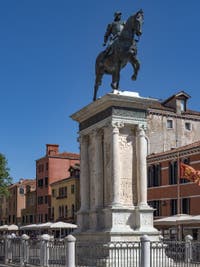
Statue of Bartolomeo Colleoni The Piazza di San Giovanni e Paolo (Campo Zanipolo) with its basilica, Colleoni and superb Scuola San Marco is an easily identifiable meeting place. Casanova himself had the pleasure of waiting for his beautiful and mysterious M.M. at the foot of the Colleoni statue.
In his Memoirs, he wrote:
“On the evening of King's Day, having my medallion in my pocket, I went early to stand sentry by the beautiful statue erected to the hero Colleoni after he had been poisoned, if the secret history does not lie.
Sit divus, modo non vivus (let him be a god, provided he is dead) is a sentence of the enlightened monarch that will last as long as there are kings.”
Giacomo Casanova
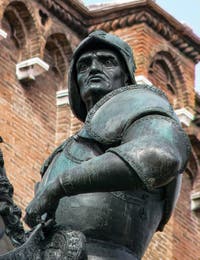
Statue of Bartolomeo Colleoni And the beautiful libertine nun, daughter of the highest nobility, shows up at the rendezvous disguised as... a cavalier.
A letter from Mr M. clearly confirms the regularity of their rendezvous near the statue of the Colleoni :
“I am sure, my heart, that you have made a lie of pure politeness; but you guessed that I expected it.
It was a wonderful gift you wanted to give our friend in exchange for the one he gave you by not objecting to his M. M. giving you his heart (...)
On Wednesday I shall be alone and all yours, at your casino in Venice: let me know if you will be at the statue of the hero Colleoni at the usual time; and if you can't make it, let me know any other day you like.”
The Sister M.M. lover of Casanova
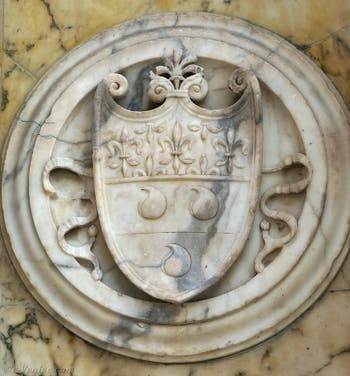
Statue of Bartolomeo Colleoni While waiting for his date, Casanova had plenty of time to observe this masterpiece.
One can imagine the great seducer meditating in front of the Colleoni coat of arms, all of which were said to have three testicles.
Calling himself Chevalier “de Seingalt” Casanova wrote the following about the right to change one's name:
“The Colleoni of Bergamo alone would at the same time be obliged to change the sign of their coat of arms, since they have on the shield of their ancient family the generative glands, and thereby destroy the glory of Bartolomeo their forefather.”
Giacomo Casanova Chevalier “de Seingalt”
Other writers were inspired by the Colleoni
Andrew Suarès, who published Le Voyage du Condottiere in 1932, visited the statue of the Colleoni every day.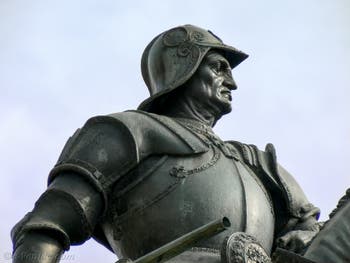
Statue of Bartolomeo Colleoni He saw himself as a proud and courageous man who despised and rejected with the utmost disdain the mediocrity of the herd chattering at his feet; a great man in the affairs of a small state, to be sure, but he was one of those who make history and spare neither their strength nor their talents to put them at the service of great causes.
Colleoni is the superb, solitary hero whose exceptional valour gave him all his glory.
Paul Morand watched him from the corner of the little café as he pondered his warlike adventures.
And in “Venises”, he writes:
“To whom is the challenge of the piercing gaze addressed, to his contemporaries or to posterity?
[...] The whole life of the great ass was spent fighting for Venice against Milan or for Sforza against the Council of Ten.”
Paul Morand
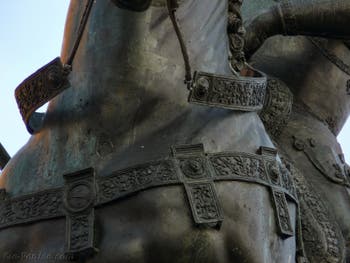
Statue of Bartolomeo Colleoni And to try to understand this man and his era, the fifteenth century and all its Italian wars and political upheavals...
“The Statue of Colleoni
The adventurer, of purer blood than royal,
Being born of that of the beautiful republics.
Leaning his slanting feet against the brazen stirrups,
And, with his left arm, picks up and holds his horse.
He opens his other arm in a loyal gesture,
Having chosen, with a heart devoted to these relics,
In the flags bearing symbolic animals,
The old Lion rather than the Imperial Eagle.
A solid driver of soldiers at his height,
With a sloe-less gaze he leads the battle,
And surely let his tactics succeed.
The mouth with drooping corners, enclosed by wrinkles,
And clenched by the pride of two dry lips,
Out of contempt for speaking does not deign to lie.”
Albert Mérat - Marble Cities 1869
“Living apotheoses too, like the statue of Colleone, arm back, legs drawn up in the stirrups, head hard and lip biting!
The statue of Colleone treading at the feet of his horse the city, space, the world.”
Jacques Adelswärd-Fersen - Our Lady of the Dead Seas 1902
Statue of Bartolomeo Colleoni “[...] the evenings of Venice; and the nights of Venice that is!
The smoky blue skies where the liquid mother-of-pearl of the moon spreads softly and calmly over the city, meshing with bright silver the expanse of the lagoons and the span of the little canals, the enchanted sleep of the Salute and the tragic vigil of the Colleone in the middle of his little square, right in the saddle, the nocturnal silence where the raised step of his horse comes to a standstill.”
Jean Lorrain - Venice - 1898-1900
Heroic figure or greedy mercenary? Opportunist? Perhaps all at once.
Or quite simply Machiavellian avant la lettre, since Machiavel was born in 1469 and published The Prince in 1507, having observed that political power cares less about the common good than about maintaining itself at the head of the state, knowing how to use force and appearances.Apparently, Colleoni was gifted with the necessary qualities: strength and cunning, backed up by willpower and courage.
And his statue is a fitting tribute to him!
Location plan of the Statue of Bartolomeo Colleoni in Venice
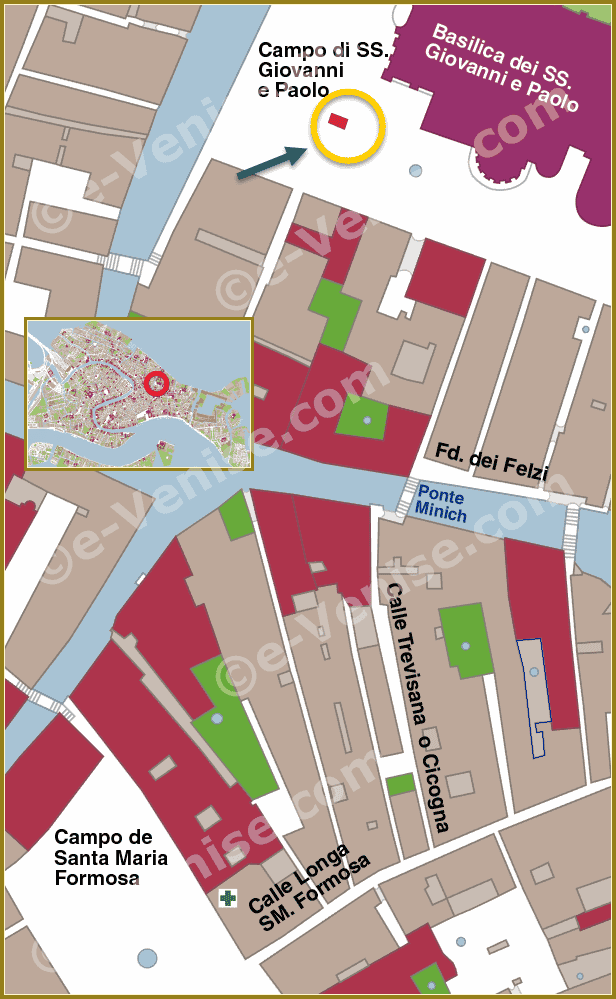
Squares Arsenal | Hunchback | Dogana | Colleoni | Rioba | Piazzetta St. Mark | Stefano | Rialto Vecchio
Back to Top of Page


